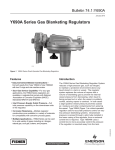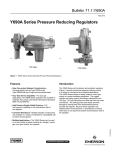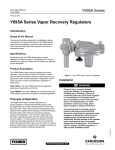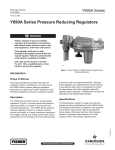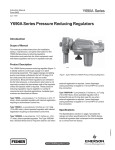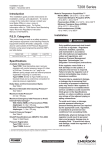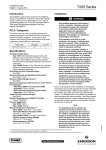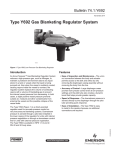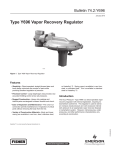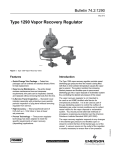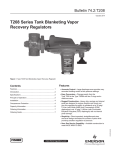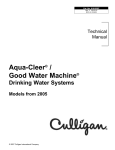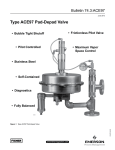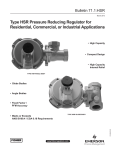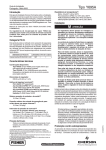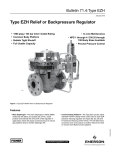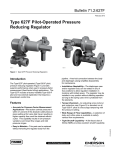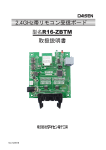Download Emerson Y695A Data Sheet
Transcript
Bulletin 74.2:Y695A January 2010 Y695A Series Vapor Recovery Regulators W7381 Figure 1. Y695A Series Vapor Recovery Regulators Features • Simplicity—Direct-operated, straightforward stem and lever design minimizes the number of parts while providing excellent regulation of pressure. • Easy Conversion—Changes easily from the Type Y695A to the Type Y695AM with two O-rings and a machine screw. Introduction • Rugged Construction—Heavy duty casings and internal parts are designed to reduce vibration and shock and give this regulator the ability to withstand 150 psig (10,3 bar) inlet pressure with no internal parts damage. The Y695A Series are direct-operated vapor recovery regulators. These regulators are used to sense an increase in vessel pressure and vent excessive internal tank pressure to an appropriate vapor recovery disposal or reclamation system. They may also be used as backpressure regulators or relief valves. D102595X012 • Precision Control—Large diaphragm area provides very accurate throttling control at low pressure settings. www.fisherregulators.com Bulletin 74.2:Y695A Specifications Available Configurations Flow Capacities Type Y695A: Direct-operated vapor recovery regulator. Type Y695AM: Direct-operated vapor recovery regulator equipped with a blocked throat and O-ring stem seal. The lower diaphragm casing is tapped 1/2 NPT for control line connection. See Table 4 Orifice Size 7/16-inch (11 mm) Construction Materials See Table 3 Body Sizes Material Temperature Capabilities(1) Nitrile: -20° to 180°F (-29° to 82°C) Fluorocarbon (FKM): 40° to 300°F (4° to 149°C) Perfluoroelastomer (FFKM): -20° to 300°F (-29° to 149°C) Ethylenepropylene (EPDM): -20° to 300°F (-29° to 149°C) NPS 3/4 or 1 (DN 20 or 25) End Connection Styles See Table 1 Maximum Allowable Inlet (Casing) Pressure(1) 150 psig (10,3 bar) Maximum Outlet Pressure(1) 150 psig (10,3 bar) Maximum Emergency Inlet Pressure to Avoid Internal Parts Damage 150 psig (10,3 bar) Adjusting Screw Spring Case Vent Connection 1/4 NPT Diaphragm Case Connection See Table 2 Flow Coefficients with Fully Open Disk Control Pressure Ranges(1) Pressure Setting Adjustment Cg: 120, CV: 3.43, C1: 35 1/2 NPT Approximate Weight 19 pounds (9 kg) 1. The pressure/temperature limits in this bulletin and any applicable standard or code limitation should not be exceeded. Table 1. End Connection Styles END CONNECTION STYLES(1) BODY SIZES, NPS (DN) Ductile Iron CF8M Stainless Steel Hastelloy® C 3/4 or 1 (20 or 25) NPT NPT, ANSI Class 150 RF, ANSI Class 300 RF, or PN 16/25/40 ANSI Class 150 RF 1. All flanges have 14-inches (356 mm) face-to-face. Table 2. Control Pressure Ranges SPRING PART NUMBER SPRING COLOR SPRING WIRE DIAMETER 2 to 7-inches w.c. (5 to 17 mbar)(1)(2) 3 to 13-inches w.c. (7 to 32 mbar)(1)(2) 10 to 26-inches w.c. (25 to 65 mbar) 1B653827052 1B653927022 1B537027052 Red Olive drab Yellow 0.085-inch (2,2 mm) 0.105-inch (2,7 mm) 0.114-inch (2,9 mm) 3.625-inches (92,1 mm) 3.75-inches (95,2 mm) 4.188-inches (106 mm) 0.9 to 2.5 psig (0,06 to 0,17 bar) 1.3 to 4.5 psig (0,09 to 0,31 bar) 3.8 to 7 psig (0,26 to 0,48 bar) 1B537127022 1B537227022 1B537327052 Light green Light blue Black 0.156-inch (4,0 mm) 0.187-inch (4,8 mm) 0.218-inch (5,5 mm) 4.060-inches (103 mm) 3.938-inches (100 mm) 3.980-inches (101 mm) RELIEF SET PRESSURE RANGE 1. Spring ranges based on spring case installed pointed down. When installed pointing up, the spring ranges increase by 2-inches w.c. (5 mbar). 2. Do not use Fluorocarbon (FKM) diaphragm with these springs at diaphragm temperatures lower than 60°F (16°C). 2 FREE LENGTH Bulletin 74.2:Y695A Table 3. Construction Materials BODY Ductile iron, CF8M Stainless steel, or Hastelloy C SPRING CASE Ductile iron or CF8M Stainless steel DIAPHRAGM CASE DISK HOLDER Ductile iron, CF8M Stainless steel, or Hastelloy C 316 Stainless steel or Hastelloy C DIAPHRAGM DISK Nitrile (NBR), Fluorocarbon (FKM), or Nitrile (NBR) with bonded Teflon (PTFE) Nitrile (NBR), Fluorocarbon (FKM), Perfluoroelastomer (FFKM), Teflon (PTFE), or Ethylenepropylene (EPDM) Table 4. Y695A Series Capacities MINIMUM BUILDUP TO WIDE-OPEN 2-inches w.c. (5 mbar) 1.5-inches w.c. (3,7 mbar) 0 psig (0 bar) 2.5 psig (0,17 bar) 5 psig (0,34 bar) 280 (7,50) 1180 (31,6) 1520 (40,7) 4-inches w.c. (10 mbar) 1.5-inches w.c. (3,7 mbar) 0 psig (0 bar) 2.5 psig (0,17 bar) 5 psig (0,34 bar) 350 (9,38) 1200 (32,2) 1530 (41,0) 3 to 13-inches w.c. (7 to 32 mbar) 1B653927022 Olive drab 10-inches w.c. (25 mbar) 2.3-inches w.c. (5,7 mbar) 0 psig (0 bar) 2.5 psig (0,17 bar) 5 psig (0,34 bar) 520 (13,9) 1250 (33,5) 1570 (42,1) 10 to 26-inches w.c. (25 to 65 mbar) 1B537027052 Yellow 15-inches w.c. (37 mbar) 3.4-inches w.c. (8,5 mbar) 0 psig (0 bar) 2.5 psig (0,17 bar) 5 psig (0,34 bar) 640 (17,2) 1300 (34,8) 1600 (42,9) 1 psig (0,07 bar) 0.40 psig (0,03 bar) 0 psig (0 bar) 2.5 psig (0,17 bar) 5 psig (0,34 bar) 940 (25,2) 1450 (38,9) 1720 (46,1) 1360 (36,4) 1730 (46,4) 1940 (52,0) 0.9 to 2.5 psig (0,06 to 0,17 bar) 1B537127022 Light green January 2010 1.3 to 4.5 psig (0,09 to 0,31 bar) 1B537227022 Light blue 2 psig (0,14 bar) 0.88 psig (0,06 bar) 0 psig (0 bar) 2.5 psig (0,17 bar) 5 psig (0,34 bar) 3.8 to 7 psig (0,26 to 0,48 bar) 1B537327052 Black 5 psig (0,34 bar) 1.66 psig (0,11 bar) 0 psig (0 bar) 2.5 psig (0,17 bar) 5 psig (0,34 bar) Type Y695A January 2010 Type Y695A B2648 INLET PRESSURE INLET PRESSURE OUTLET PRESSURE OUTLET PRESSURE ATMOSPHERIC PRESSURE ATMOSPHERIC PRESSURE INLET PRESSURE FigurePRESSURE 2. Y695A Series OUTLET ATMOSPHERIC PRESSURE Type Y695A Type Y695A 2110 (56,5) 2330 (62,4) 2470 (66,2) MXXXX 2 to 7-inches w.c. (5 to 17 mbar) 1B653827052 Red VACUUM OUTLET PRESSURE CAPACITIES IN SCFH (Nm3/h) OF 0.97 SPECIFIC GRAVITY NITROGEN SET PRESSURE MXXXX SPRING RANGE, PART NUMBER, and COLOR Operational Schematic 3 Bulletin 74.2:Y695A Table 5. Materials Compatibility CORROSION INFORMATION Monel®(1) Hastelloy® C(2) Hastelloy® C(2) S41600 Stainless Steel Monel® (1) CF8M or S31600 Stainless Steel S41600 Stainless Steel C C A A A B A A A A B A A A A C C A A A B A A A A A A A A A Hydrochloric Acid (Air free) Hydrogen Hydrogen Peroxide Hydrogen Sulfide (Liquid) Magnesium Hydroxide Aluminum Sulfate Ammonia Ammonium Chloride Ammonium Nitrate Ammonium Sulfate C A C A C C A C C C A A B A B A A B A A C A C C C B A B C A A A A A A Methanol Methyl Ethyl Ketone Natural Gas Nitric Acid Petroleum Oils (Refined) Ammonium Sulfite Beer Benzene (Benzol) Benzoic Acid Boric Acid C B A C C C B A C C A A A A A A A A A A B B A A B C A A A A A A A A A Butane Calcium Chloride (Alkaline) Carbon Dioxide (Dry) Carbon Dioxide (Wet) Carbon Disulfide A B A C A A B A C A A C A A A A B A A A A C A A B A A A A B B C A C C B C A C C B B B C C B B B C C C A C C C Chromic Acid Citric Acid Coke Oven Gas Copper Sulfate Ether C I.L. A C B C C A C B C B A B A B A A B A Ethyl Chloride Ethylene Ethylene Glycol Formaldehyde Formic Acid C A A B I.L. C A A B C A A A A B B B A A C B B A A C B A A A C Freon (Wet) Freon (Dry) Gasoline (Refined) Glucose Hydrochloric Acid (Aerated) S30200 or S30400 Stainless Steel CF8M or S31600 Stainless Steel C C A A A Carbon Tetrachloride Carbonic Acid Chlorine Gas (Dry) Chlorine Gas (Wet) Chlorine (Liquid) Cast or Ductile Iron S30200 or S30400 Stainless Steel Acetic Acid (Air Free) Acetic Acid Vapors Acetone Acetylene Alcohols Fluid Carbon Steel Cast or Ductile Iron Material Carbon Steel Material C A I.L. C A C A A C A C A A A A C A A A A C A B C A C A A C A B A B A A A A A C A A A A C A A A A A A A A A B A A A A C A A A A C A A A A B A Phosphoric Acid (Air Free) Phosphoric Acid Vapors Potassium Chloride Potassium Hydroxide Propane C C B B A C C B B A A B A A A A A A B A C C C B A B C B A A A I.L. A A A A A A A A Silver Nitrate Sodium Acetate Sodium Carbonate Sodium Chloride Sodium Chromate C A A C A C A A C A A B A B A A A A B A B A B B A C A A A A A A A A A A A A C C A A A B A Sodium Hydroxide Stearic Acid Sulfur Sulfur Dioxide (Dry) Sulfur Trioxide (Dry) A A A A A A C A A A A A A A A A A A A A B B A B B A B A A A A A A A A C B A A A A B B C A A A A A A Sulfuric Acid (Aerated) Sulfuric Acid (Air Free) Sulfurous Acid Trichloroethylene Water (Boiler Feed) C C C B B C C C B C C C B B A C C B A A C C C B B C B C A A A A A A A A A A A B B A A A C A A A A A A A I.L. A A Water (Distilled) Water (Sea) Zinc Chloride Zinc Sulfate A B C C A B C C A B C A A B C A B C C B A A C A A A A A A A A A C I.L. I.L. A A C A A A A C A A A A B 1. Monel is a trademark of International Nickel Co. 2. Hastelloy is a trademark of Stelite Div., Cabot Corp. Fluid ---- ---- ---- ---- ---- ---- ---- ---- A+--Best possible selection A--Recommended B--Minor to moderate effect. Proceed with caution. C--Unsatisfactory I.L.--Information lacking - continued - Principle of Operation Y695A Series vapor recovery regulators are used to maintain a constant blanket (inlet) pressure or vessel pressure with the outlet flowing to a system whose pressure is lower than the inlet (see Figure 2). 4 When vessel pressure increases above the setpoint of the regulator due to pumping in or thermal heating, the force of the control spring is overcome by pressure acting on the diaphragm. This moves the disk away from the orifice, allowing gas to flow from the vessel to the vapor recovery system. As vessel pressure is Bulletin 74.2:Y695A Table 5. Materials Compatibility (continued) FLUID INFORMATION Material Fluid Neoprene (CR) Nitrile (NBR) Fluorocarbon (FKM) Perfluoroelastomer (FFKM) Ethylenepropylene (EPDM) c b a a+ A B C A A C B C B C C A A A A A A A A A A B C A B A B C C A C A+ A C A B B A A A A A A A A B C A C C C Carbon Tetrachloride Chlorine (Dry) Chlorine (Wet) Coke Oven Gas Ethyl Acetate C C C C C C C C B C A A A A+ C A A A A A C C C C B Ethylene Glycol Freon 11 Freon 12 Freon 22 Freon 114 A B A+ A+ A A A A C A A A+ B C B A A A A A A C B A A Gasoline Hydrogen Gas Hydrogen Sulfide (Dry) Hydrogen Sulfide (Wet) Jet Fuel (JP-4) B A A B C A+ A C C A A A C C A A A A A A C A A A I.L. Natural Gas Natural Gas + H2S (Sour Gas) Nitric Acid (20%) Nitric Acid (50 to 100%) Nitrogen A A B C A A+ B C C A A C A A A A A A A A C C C C A Oil (Fuel) Propane Sulfur Dioxide Sulfuric Acid (to 50%) Sulfuric Acid (50 to 100%) B A B A B A+ A A C C A A A A A A A A A A C C A A B Water (Ambient) Water [at 200°F (93°C)] Water (Sea) C A C C A B A A B A A A B A A Acetic Acid (30%) Acetone Alcohol (Ethyl) Alcohol (Methyl) Ammonia (Anhydrous) Ammonia (Gas, Hot) Benzene Brine (Calcium Chloride) Butadiene Gas Butane (Gas) Butane (Liquid) A+--Best possible selection A--Recommended B--Minor to moderate effect. Proceed with caution. C--Unsatisfactory I.L.--Information lacking reduced, the force of the back disk spring causes the disk to move toward the orifice, decreasing the flow of gas out of the vessel. As vessel pressure drops below the setpoint of the regulator, the disk will seat against the orifice, shutting off the flow of gas. Sizing Vapor Recovery Systems To determine the capacity required, you must consider the amount of blanketing gas that must be displaced from the tank when either filling the vessel with liquid (pump-in) or the expansion of tank vapors during atmospheric thermal heating. Using the established procedures from American Petroleum Institute Standard 2000 (API 2000), determine the required flow rate for outbreathing. For liquids with a flash point below 100°F (38°C) or a normal boiling point below 300°F (149°C), multiply the calculated outbreathing requirements in Table 6 by 2.0 as indicated in footnote 1 from Table 6. 5 Bulletin 74.2:Y695A Table 6. Flow Rate Conversions (Gas flow required to displace blanketing gas with pump-in of liquid.) MULTIPLY MAXIMUM PUMP RATE IN BY TO OBTAIN U.S. GPM U.S. GPH Barrels/hour Barrels/day 8.021 0.1337 5.615 0.2340 SCFH air required(1)(2) 1. For liquids with a flash point below 100°F (38°C) or normal boiling point below 300°F (149°C), multiply the above calculated outbreathing requirement by 2.0. 2. To convert to Nm³/h multiply scfh by 0.0268. 1. Determine the flow rate of blanketing gas displaced when liquid is being pumped in (see Table 6). 2. Determine the gas flow rate due to “outbreathing” caused by atmospheric thermal heating (see Table 7). 3. Add the requirements of steps 1 and 2 and select a vapor recovery regulator size based on total capacity required from Table 4. Sample sizing problem for vapor recovery applications: Vessel capacity . . . . . . 1000 barrels (42,000 gal)(159 000 liters) Pump in capacity . . . . . . . . . . . . . . . . . 20 GPM (75,7 l/min) Inlet pressure source . . . . . . . . 60 psig (4,14 bar) nitrogen Desired blanket setpoint . . . . . . . . 0.5-inches w.c. (1 mbar) Desired vapor recovery setpoint . . . 2-inches w.c. (5 mbar) Vapor recovery vacuum source . . . 5-inches Hg (169 mbar) Fluid . . . . . . . . . . . . . . . . . . . . . . . . . . . . . . . . . . . . . Hexane Boiling point . . . . . . . . . . . . . . . . . . . . . . . . . . 155°F (68°C) 1. From Table 6 the desired air flow rate due to pump in equals 20 gpm (75,7 l/min) x 8.021 x 2 = 321 scfh (8,60 Nm3/h) air. 2. From Table 7 the desired air flow rate = 1000 scfh (26,8 Nm3/h) air due to thermal heating. 3. Total required flow rate = 1000 scfh (26,8 Nm3/h) air + 320 scfh (8,58 Nm3/h) = 1320 scfh (35,4 Nm3/h) air. This converts to nitrogen requirements of 1340 scfh (35,9 Nm3/h). Capacity Information Table 4 gives typical nitrogen regulating capacities at selected inlet pressures and outlet pressure settings. Flows are in scfh at 60°F and 14.7 psia and Nm³/h at 0°C and 1,01325 bar of 0.97 specific gravity nitrogen. For gases of other specific gravities, multiply the 6 Table 7. Gas Flow Required for Thermal Heating (Outbreathing) per API 2000 (Interpolate for intermediate sizes.) VESSEL CAPACITY Barrels Gallons Liters 60 100 500 1000 2000 2500 4200 21,000 42,000 84,000 9500 15 000 79 500 159 000 318 000 3000 4000 5000 10,000 15,000 126,000 168,000 210,000 420,000 630,000 20,000 25,000 30,000 35,000 40,000 SCFH (Nm³/h) AIR FLOW RATE REQUIRED Flash point is equal Flash point is to or above 100°F below 100°F (38°C) or normal (38°C) or boiling point is normal boiling equal to or above point is below 300°F (149°C) 300°F (149°C) 40 (1,07) 60 (1,61) 300 (8,04) 600 (16,1) 1200 (32,2) 60 (1,61) 100 (2,68) 500 (13,4) 1000 (26,8) 2000 (53,6) 477 000 636 000 795 000 1 590 000 2 385 000 1800 2400 3000 6000 9000 3000 (80,4) 4000 (107) 5000 (134) 10,000 (268) 15,000 (402) 840,000 1,050,000 1,260,000 1,470,000 1,680,000 3 180 000 3 975 000 4 769 000 5 564 000 6 359 000 12,000 15,000 17,000 19,000 21,000 (322) (402) (456) (509) (563) 20,000 24,000 28,000 31,000 34,000 45,000 50,000 60,000 70,000 80,000 1,890,000 2,100,000 2,520,000 2,940,000 3,360,000 7 154 000 7 949 000 9 539 000 11 129 000 12 718 000 23,000 24,000 27,000 29,000 31,000 (616) (643) (724) (777) (831) 37,000 (992) 40,000 (1072) 44,000 (1179) 48,000 (1286) 52,000 (1394) 90,000 100,000 120,000 140,000 160,000 3,780,000 4,200,000 5,040,000 5,880,000 6,720,000 14 308 000 15 898 000 19 078 000 22 257 000 25 437 000 34,000 (911) 36,000 (965) 41,000 (1099) 45,000 (1206) 50,000 (1340) 56,000 60,000 68,000 75,000 82,000 180,000 7,560,000 28 616 000 54,000 (1447) 90,000 (2412) (48,2) (64,3) (80,4) (161) (241) (536) (643) (750) (831) (911) (1501) (1608) (1822) (2010) (2198) given capacity of nitrogen by 0.985, and divide by the square root of the appropriate specific gravity of the gas required. To determine regulating capacities at pressure settings not given or to determine wide-open flow capacities, use the following formula: Q= 3417 520 CgP1SIN C1 GT ∆P P1 Deg. Where: Cg = gas sizing coefficient from Specifications C1 = Cg/Cv or 35 from Specifications G = gas specific gravity (air = 1.0) P1abs = inlet pressure, psia (add 14.7 psi to gauge inlet pressure to obtain absolute inlet pressure) Q = flow rate, scfh T = absolute temperature in °Rankine of gas at inlet (°Rankine = °F + 460) ∆P = Pressure differential across the valve, psig (P1 - P2) Bulletin 74.2:Y695A Installation full flow valve between the regulator and the blanketed vessel. For proper operation at low setpoint ranges, the regulators should be installed with the spring case pointed down. Install the regulator using a straight run of pipe the same size or larger as the regulator body. Flow through the regulator body is indicated by the flow arrow on the body. If a block valve is required, install a G F D 8.38 (213) DIAMETER B 14 (356) A 5.56 (141) INCHES (mm) B2441 DIMENSIONS, INCHES (mm) BODY SIZE, NPS (DN) 3/4,1 (20, 25) A B Iron Stainless Steel or Hastelloy® C 4.0 (102) 4.12 (105) D Ductile Iron Stainless Steel or Hastelloy® C 2.12 (54) 2.25 (57) F Ductile Iron Stainless Steel or Hastelloy® C 6.19 (157) 6.19 (157) G Ductile Iron Stainless Steel or Hastelloy® C Ductile Iron Stainless Steel or Hastelloy® C 10.38 (264) 10.38 (264) 1.69 (43) 1.69 (43) Figure 3. Dimensions 7 Bulletin 74.2:Y695A Ordering information 5. Flow rates a) Minimum controlled flow b) Normal flow c) Maximum flow 6. Line size and end connection size of adjacent piping. When ordering, specify: Application 1. Type of gas being controlled (natural gas, air, etc.); list any factors such as impurities in the gas that may affect compatibility of gas with the regulator trim parts. 2. Specific gravity of the gas. 3. Temperature of the gas. 4. Range of flowing inlet pressures to regulator. Regulator Refer to the Specifications table on page 2. Carefully review the description of each specification and make the desired selection wherever there is a choice. Always specify the type number. Industrial Regulators Natural Gas Technologies TESCOM Emerson Process Management Regulator Technologies, Inc. Emerson Process Management Regulator Technologies, Inc. Emerson Process Management Tescom Corporation USA - Headquarters McKinney, Texas 75069-1872 USA Tel: 1-800-558-5853 Outside U.S. 1-972-548-3574 USA - Headquarters McKinney, Texas 75069-1872 USA Tel: 1-800-558-5853 Outside U.S. 1-972-548-3574 USA - Headquarters Elk River, Minnesota 55330-2445 USA Tel: 1-763-241-3238 Asia-Pacific Shanghai, China 201206 Tel: +86 21 2892 9000 Asia-Pacific Singapore, Singapore 128461 Tel: +65 6777 8211 Europe Bologna, Italy 40013 Tel: +39 051 4190611 Europe Bologna, Italy 40013 Tel: +39 051 4190611 Gallardon, France 28320 Tel: +33 (0)2 37 33 47 00 Middle East and Africa Dubai, United Arab Emirates Tel: +971 4811 8100 Europe Selmsdorf, Germany 23923 Tel: +49 (0) 38823 31 0 For further information visit www.fisherregulators.com The Emerson logo is a trademark and service mark of Emerson Electric Co. All other marks are the property of their prospective owners. Fisher is a mark owned by Fisher Controls, Inc., a business of Emerson Process Management. The contents of this publication are presented for informational purposes only, and while every effort has been made to ensure their accuracy, they are not to be construed as warranties or guarantees, express or implied, regarding the products or services described herein or their use or applicability. We reserve the right to modify or improve the designs or specifications of such products at any time without notice. Emerson Process Management does not assume responsibility for the selection, use or maintenance of any product. Responsibility for proper selection, use and maintenance of any Emerson Process Management product remains solely with the purchaser. ©Emerson Process Management Regulator Technologies, Inc., 1999, 2010; All Rights Reserved








